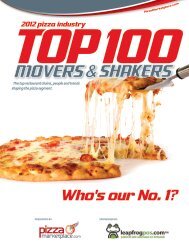2012 100 - Networld Media Group
2012 100 - Networld Media Group
2012 100 - Networld Media Group
You also want an ePaper? Increase the reach of your titles
YUMPU automatically turns print PDFs into web optimized ePapers that Google loves.
90<br />
ELECTRONIC SHELF LABELS<br />
Given the headaches and hours of labor it takes to keep prices accurate<br />
and up to date for a superstore’s worth of product, electronic shelf<br />
labels would seem to be a no-brainer. Yet ESLs, while widely used<br />
in Europe and parts of the West Coast, have seen only limited, experimental<br />
use in other locales. ESLs connect to a storewide network,<br />
communicate with the retailer’s POS system and download prices to<br />
labels at the store, or from a corporate location for numerous store locations<br />
simultaneously. ESLs can also display additional information<br />
via a touchscreen interface such as nutritional information, priceper-measure,<br />
or even recipes. Even though the cost of implementing<br />
ESLs has decreased over the years thanks to improvements in battery<br />
technology and economies of scale, there are still significant startup<br />
costs. The tipping point for ESLs will come if and when there are sufficient<br />
gains in flexible and responsive pricing to justify the cost difference<br />
over cheaper labels.<br />
91<br />
TESCO<br />
CEO Phillip Clarke is confident about<br />
the future of Tesco’s Fresh & Easy<br />
Neighborhood Market because of the<br />
enthusiasm and loyalty of its customer<br />
base, despite the company’s decision<br />
to shutter 13 underperforming units.<br />
“The key components are coming to-<br />
89<br />
RFID IN RETAIL<br />
If the predictions of RFID advocates have their way, grocery store checkout<br />
lines will soon be a thing of the past. RFID technology uses ink laced with<br />
carbon nanotubes to print electronics directly onto items such as cereal boxes<br />
and potato chip bags, and then transmits information about an entire cartload<br />
of groceries when the shopper wheels past a detector that instantly tabulates<br />
the total. RFID also gives retailers an unprecedented ability to fully track<br />
and trace inventory throughout the supply chain from source to shelf to final<br />
sale with near-perfect accuracy. Research conducted by Dr. Bill Hardgrave of<br />
the University of Arkansas RFID Research Center shows that RFID is capable<br />
of accuracy rates topping 99 percent.<br />
gether,” Clarke says, for Fresh & Easy<br />
to achieve profitability in <strong>2012</strong> or 2013,<br />
by which time Tesco expects to be operating<br />
close to 400 U.S. stores. For the<br />
six-month period that ended Aug. 31,<br />
2011, Tesco’s U.S. division, which then<br />
encompassed 159 stores, lost $151<br />
million, while sales rose 47 percent to<br />
$392.7 million and same-store sales<br />
rose approximately 10 percent. The<br />
chain experienced additional losses,<br />
due to costs related to its acquisition of<br />
two suppliers, and increased rent from<br />
unopened stores.<br />
43



